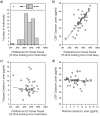Preference for novel faces in male infant monkeys predicts cerebrospinal fluid oxytocin concentrations later in life
- PMID: 29021623
- PMCID: PMC5636831
- DOI: 10.1038/s41598-017-13109-5
Preference for novel faces in male infant monkeys predicts cerebrospinal fluid oxytocin concentrations later in life
Abstract
The ability to recognize individuals is a critical skill acquired early in life for group living species. In primates, individual recognition occurs predominantly through face discrimination. Despite the essential adaptive value of this ability, robust individual differences in conspecific face recognition exist, yet its associated biology remains unknown. Although pharmacological administration of oxytocin has implicated this neuropeptide in face perception and social memory, no prior research has tested the relationship between individual differences in face recognition and endogenous oxytocin concentrations. Here we show in a male rhesus monkey cohort (N = 60) that infant performance in a task used to determine face recognition ability (specifically, the ability of animals to show a preference for a novel face) robustly predicts cerebrospinal fluid, but not blood, oxytocin concentrations up to five years after behavioural assessment. These results argue that central oxytocin biology may be related to individual face perceptual abilities necessary for group living, and that these differences are stable traits.
Conflict of interest statement
The authors declare that they have no competing interests.
Figures

Similar articles
-
A behavioral face preference deficit in a monkey with an incomplete face patch system.Neuroimage. 2019 Apr 1;189:415-424. doi: 10.1016/j.neuroimage.2019.01.043. Epub 2019 Jan 18. Neuroimage. 2019. PMID: 30665007
-
Seeing two faces together: preference formation in humans and rhesus macaques.Anim Cogn. 2014 Sep;17(5):1107-19. doi: 10.1007/s10071-014-0742-3. Epub 2014 Mar 18. Anim Cogn. 2014. PMID: 24638876
-
What can we learn about human individual face recognition from experimental studies in monkeys?Vision Res. 2019 Apr;157:142-158. doi: 10.1016/j.visres.2018.03.012. Epub 2018 Sep 13. Vision Res. 2019. PMID: 31230664 Review.
-
Preference for attractive faces is species-specific.J Comp Psychol. 2019 May;133(2):262-271. doi: 10.1037/com0000148. Epub 2018 Dec 13. J Comp Psychol. 2019. PMID: 30550303
-
Measuring peripheral oxytocin and vasopressin in nonhuman primates.Am J Primatol. 2018 Oct;80(10):e22871. doi: 10.1002/ajp.22871. Epub 2018 May 14. Am J Primatol. 2018. PMID: 29756649 Review.
Cited by
-
Opportunities and challenges for intranasal oxytocin treatment studies in nonhuman primates.Am J Primatol. 2018 Oct;80(10):e22913. doi: 10.1002/ajp.22913. Epub 2018 Oct 3. Am J Primatol. 2018. PMID: 30281820 Free PMC article.
-
Bridging the gap between rodents and humans: The role of non-human primates in oxytocin research.Am J Primatol. 2018 Oct;80(10):e22756. doi: 10.1002/ajp.22756. Epub 2018 Jun 19. Am J Primatol. 2018. PMID: 29923206 Free PMC article. Review.
-
Neurobiological Aspects of Face Recognition: The Role of Oxytocin.Front Behav Neurosci. 2018 Aug 28;12:195. doi: 10.3389/fnbeh.2018.00195. eCollection 2018. Front Behav Neurosci. 2018. PMID: 30210321 Free PMC article. Review.
-
An integrated framework for the role of oxytocin in multistage social decision-making.Am J Primatol. 2018 Oct;80(10):e22735. doi: 10.1002/ajp.22735. Epub 2018 Jan 19. Am J Primatol. 2018. PMID: 29350419 Free PMC article. Review.
-
Behavioral effects of postnatal ketamine exposure in rhesus macaque infants are dependent on MAOA-LPR genotype.Dev Psychobiol. 2019 May;61(4):605-614. doi: 10.1002/dev.21843. Epub 2019 Mar 13. Dev Psychobiol. 2019. PMID: 30868562 Free PMC article.
References
-
- Cheney DL, Seyfarth RM. The recognition of social alliances by vervet monkeys. Anim. Behav. 1986;34:1722–1731. doi: 10.1016/S0003-3472(86)80259-7. - DOI
-
- Marechal L, Genty E, Roeder JJ. Recognition of faces of known individuals in two lemur species (Eulemur fulvus and E. macaco) Anim. Behav. 2010;79:1157–1163. doi: 10.1016/j.anbehav.2010.02.022. - DOI
Publication types
MeSH terms
Substances
Grants and funding
LinkOut - more resources
Full Text Sources
Other Literature Sources

